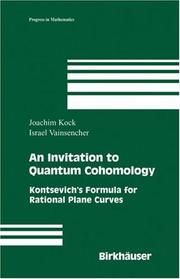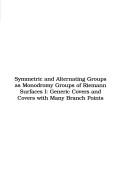| Listing 1 - 3 of 3 |
Sort by
|

ISBN: 0817644563 9780817644567 0817644954 Year: 2007 Volume: 249 Publisher: Boston Birkhauser
Abstract | Keywords | Export | Availability | Bookmark
 Loading...
Loading...Choose an application
- Reference Manager
- EndNote
- RefWorks (Direct export to RefWorks)
Geometry, Enumerative --- Quantum theory --- Curves, Plane --- Homology theory --- 512.73 --- Quantum dynamics --- Quantum mechanics --- Quantum physics --- Physics --- Mechanics --- Thermodynamics --- Cohomology theory --- Contrahomology theory --- Algebraic topology --- Higher plane curves --- Plane curves --- 512.73 Cohomology theory of algebraic varieties and schemes --- Cohomology theory of algebraic varieties and schemes

ISBN: 9780821839928 Year: 2007 Publisher: Providence American Mathematical Society
Abstract | Keywords | Export | Availability | Bookmark
 Loading...
Loading...Choose an application
- Reference Manager
- EndNote
- RefWorks (Direct export to RefWorks)
Differential geometry. Global analysis --- 51 <082.1> --- Mathematics--Series --- Permutation groups. --- Curves. --- Monodromy groups. --- Riemann surfaces. --- Symmetry groups. --- Groupes de permutations. --- Courbes. --- Groupes de monodromie. --- Riemann, Surfaces de. --- Groupes de symétrie. --- Curves --- Monodromy groups --- Permutation groups --- Riemann surfaces --- Symmetry groups --- Groups, Symmetry --- Symmetric groups --- Crystallography, Mathematical --- Quantum theory --- Representations of groups --- Surfaces, Riemann --- Functions --- Substitution groups --- Group theory --- Calculus --- Conic sections --- Geometry, Analytic --- Geometry, Differential --- Geometry, Enumerative --- Mathematics --- Shapes
Book
ISBN: 0817644954 Year: 2007 Volume: 249 Publisher: Boston, MA : Birkhäuser Boston : Imprint: Birkhäuser,
Abstract | Keywords | Export | Availability | Bookmark
 Loading...
Loading...Choose an application
- Reference Manager
- EndNote
- RefWorks (Direct export to RefWorks)
This book is an elementary introduction to stable maps and quantum cohomology, starting with an introduction to stable pointed curves, and culminating with a proof of the associativity of the quantum product. The viewpoint is mostly that of enumerative geometry, and the red thread of the exposition is the problem of counting rational plane curves. Kontsevich's formula is initially established in the framework of classical enumerative geometry, then as a statement about reconstruction for Gromov–Witten invariants, and finally, using generating functions, as a special case of the associativity of the quantum product. Emphasis is given throughout the exposition to examples, heuristic discussions, and simple applications of the basic tools to best convey the intuition behind the subject. The book demystifies these new quantum techniques by showing how they fit into classical algebraic geometry. Some familiarity with basic algebraic geometry and elementary intersection theory is assumed. Each chapter concludes with some historical comments and an outline of key topics and themes as a guide for further study, followed by a collection of exercises that complement the material covered and reinforce computational skills. As such, the book is ideal for self-study, as a text for a mini-course in quantum cohomology, or as a special topics text in a standard course in intersection theory. The book will prove equally useful to graduate students in the classroom setting as to researchers in geometry and physics who wish to learn about the subject.
Geometry, Enumerative. --- Quantum theory. --- Homology theory. --- Curves, Plane. --- Cohomology theory --- Contrahomology theory --- Algebraic topology --- Quantum dynamics --- Quantum mechanics --- Quantum physics --- Physics --- Mechanics --- Thermodynamics --- Higher plane curves --- Plane curves --- Geometry, algebraic. --- K-theory. --- Mathematical physics. --- Algebraic topology. --- Geometry. --- Mathematics. --- Algebraic Geometry. --- K-Theory. --- Mathematical Methods in Physics. --- Algebraic Topology. --- Applications of Mathematics. --- Math --- Science --- Mathematics --- Euclid's Elements --- Physical mathematics --- Homology theory --- Algebraic geometry --- Geometry --- Topology --- Geometry, Algebraic. --- Algebraic geometry. --- Physics. --- Applied mathematics. --- Engineering mathematics. --- Engineering --- Engineering analysis --- Mathematical analysis --- Natural philosophy --- Philosophy, Natural --- Physical sciences --- Dynamics
| Listing 1 - 3 of 3 |
Sort by
|

 Search
Search Feedback
Feedback About
About Help
Help News
News